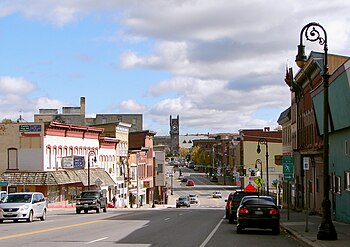 |
| Main Street |
Few people knew of its existence until the recent manhunt for convicted killers Richard Matt and David Sweat.
 |
| Lake Titus from Elephant's Head |
In the course of the manhunt, Neil was detained in the perimeter as thousands of Law Enforcement Officers (LEO) guarded 22 miles of wilderness--places I've hiked and kayaked. Areas where my friends live.
Friends had to leave their homes and seek safety with relatives. Others armed themselves, some with guns, others with wasp spray or ankle-biting dogs.
No one had peace.
 |
| The Salmon Rive above the falls |
The LEOs swarmed downtown, the area by Elephant's Head, Fayette Road and the the dam at Chasm Falls where the Salmon River spills to lower levels and flows through the village.
Each of these men and women--many of them my friends--were heroes. Yet the man who finally brought down the last of the murders, Jay Cook, was not even part of the manhunt.
On the day he encountered Sweat, he was going about his business, doing his job--a mundane assignment of patrolling the area. Alerted by Sweat's appearance and behavior, educated in who to look for, conscientious in performing his duty, he brought the last of the men who held a town hostage for weeks.
The lesson here has little to do with two heinous men, but our own simple lives. We can be heroes simply by doing our jobs and living our lives in the manner we were trained to do. The teacher need not stop a sniper, but her love for a student could end the abuse he endures. The shopping clerk can be the solace for the lonely widow who has no one to talk to. The retired worker from Alcoa can check on his neighbor in times of trial and save a life.
Malone, NY is a filled with heroes--the LEOs deserve their kudos. But remember, we, too can be a hero.
And end of blog for today--but I have two odd "commercial" announcements.
My debut novel: DWF: Divorced White Female takes place in the heart of the search zone:
- Cheryl Chandler, the protagonist, lives in Mountain View
- her home on Moose Hill Road is, in fact, a fictionalized Wolf Pond Road--where the hunting camps are
- she snowmobiled along the roads Sweat and Matt took
- Marina, her baby, was born in Alice Hyde Hospital.
- Check it out on Amazon.com--click on the picture above for a direct link
Then, I've extensively dealt with Malone, NY on this blog: Dutch Shultz, wolf-head scandals, Underground Railroad and much more. Type in Malone in the blog search and you'll find more.
Leave a comment. I'd love to hear your thoughts.








